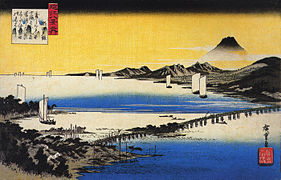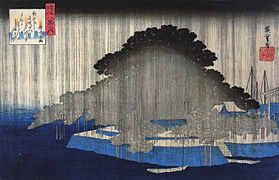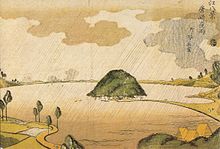Eight views of Lake Biwa
The Eight Views of Lake Biwa , actually Eight Views of Ōmi ( Japanese 近 江 八景 , " Ōmi Hakkei"), is the title of many series of pictures and poems in which Japanese graphic artists, painters and poets depict places and landscapes around Lake Biwa presented in atmospheric pictures and texts.
Preliminary remark
The Eight Views were created from the 15th century based on the Chinese "Eight Views of Xiāoxiāng". These refer to the landscape at the confluence of the Xiāo and Xiāng rivers in the Dongting Lake , an area with excellent atmosphere. While the Chinese model often only defines the places according to their type, for example as a fishing village, a fixed set of real places on Lake Biwa developed in Japan by 1600 . It is located near Kyōto , where not only the Tennō lived, but also the Ashikaga shogunate had its seat in the Muromachi district. In addition, the southern part, surrounded by mountains, offers a varied environment. There is no fixed order, below the views are described in order starting from the east. The images shown in the gallery are woodcuts by Utagawa Hiroshige .
The individual views
Autumn moon over Ishiyama
( Ishiyama no Shūgetsu , 石山 の 秋月 ): The Ishiyama temple is not located on the lake, but a little south of its outflow, the Seta. As the name Ishiyama ("stone mountain") suggests, it is built on the slope of a striking rock formation. With its location on the slope, it resembles the Kiyomizu Temple in Kyoto. A hut on the edge of the temple grounds allows a view of the lake and the autumn moon. The temple is also known because, according to legend, the lady-in-waiting Murasaki Shikibu wrote the novel about the shining Prince Genji, the Genji Monogatari , in the temple around the year 1000 .
Evening snow on Mount Hira
( Hira no Bosetsu , 比 良 の 暮 雪 ): Mount Hira on the western shore of the lake is the highest point in the Hira mountain range. In winter, the monsoons coming from the Asian mainland drive the snow far into the country at this narrow part of Japan.
Returning sails at Yabase
( Yabase no kihan , 八 橋 の 帰 帆 ): Yabase is an old port on the east bank of the lake. Located near the Tōkaidō , it was used to translate to Ōtsu , which saved the traveler a few kilometers. After 1869 even steamers docked there, but this time was already over in 1889 when the railway line Tōkyo-Kyōto was completed. Today the port is completely abandoned, there is a park in the middle of industrial facilities.
Evening light at Seta
( Seta no sekishō , 瀬 田 の 夕照 ): In pictures you can always see the large bridge that crosses the Seta using a small river island, of course in the evening light. The Tōkaidō ran over this bridge called Setagawa-no-karahashi. Today's bridge is a concrete replica, but in kara = Chinese style, with giboshi on the railing post.
In the background you can see the "Fuji of Ōmi", the Mikamiyama. Although it is only 417 m high, it actually towers over the area.
Fresh breeze at Awazu
( Awazu no seiran , 粟 津 の 晴 嵐 ): Awazu is known for its pine forest. Awazu-ga-hara between Seta and Zeze . Minamoto no Yoshinaka (born 1154) fell in the area in 1184 in an argument with his younger brother Yoshitsune and was buried there. In Zeze, the Honda family's castle stood on a ledge on Lake Biwa; she can occasionally be seen on woodcuts for Awazu. It was abandoned in 1870, today only sparse remains can be seen.
Evening bell of the Miidera
( Mii no banshō , 三井 の 晩 鐘 ): The Mii-dera was founded at the end of the 8th century, then expanded a little later by the priest Enshin 859 to its current meaning. The temple has one of the "three bells" of Japan; it is almost two meters high. There are many legends about her, the best known of the strong benkei (1155–1189). The current bell was not cast until 1602. Ernest Fenollosa is buried on the site of a secondary temple .
Night rain on Karasaki
( Karasaki no yau , 唐 崎 の 夜雨 ): Karasaki is a stone-encased ledge on the edge of the lake on which a single, strikingly large pine - hitotsu-matsu - stands. A shrine is part of a natural monument. The pine had to be replanted occasionally, the current one dates from the 20th century.
Watering wild geese near Katata
( Katata no rakugan , 堅 田 の 落雁 ): You can't always see watering geese there, but you can see the small temple, which stands on stilts away from the shore and is connected to it by a small bridge. The Hōkyō-style temple is called Ukimidō. The "uki" is known from the term ukiyo-e , it means "floating on the water, detached". Midō is a name for a temple.
The views
Another “Eight Views” in Japan
The success of his series inspired Hiroshige to produce almost 20 more series Ōmi Hakkei. But other artists also deal with the eight views. Hiroshige and other artists then adopted the theme for other areas of Japan. The right places only had to be found for the atmospheric specifications such as "Fresh Breeze". So there are from Hiroshige z. B. the "Eight Views of Edo", the "Eight Views of Kanazawa ".
Final remark
The theme of the Eight Views kept the arts and literature in Japan busy until the 20th century. So z. B. Itō Shinsui (1898–1972) presented a complete series. The German Max Dauthendey , who also visited Japan on a trip around the world in 1905, took up the topic and published the “Eight Faces at Lake Biwasee” in 1911, which was a great success.
literature
- Nihon no Bijutsu, Shōshō hakkei zu (The Art of Japan. Issue 124: Pictures of the 8th views of Shōshō) 1976.
- Ukiyoe hakka. Hiroshige (the 8 greats of Ukiyoe. Hiroshige). Publisher Heibonsha, 1984.
- Catalog of all Woodblock Prints of Shinsui Itō. The Folk Museum of Ōta Borough, 1993.










